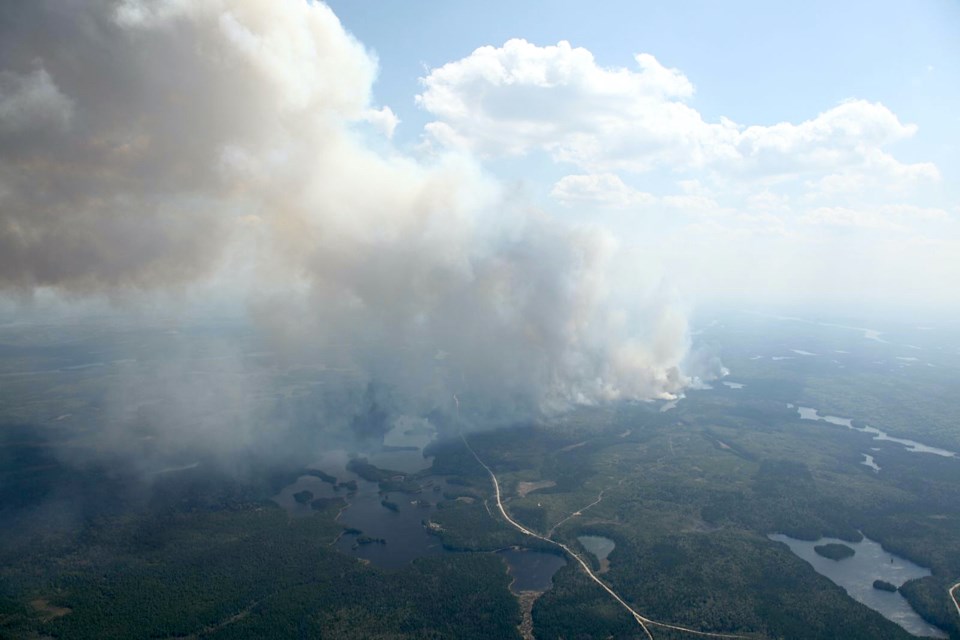It was a summer most Timmins residents will never forget.
The 2012 forest fire season was a particularly active one in Northeastern Ontario. Locally, the blaze called 'Timmins 9' sparked an emergency situation for the city and kept everyone on edge.
Timmins Fire Chief Tom Laughren was the mayor at the time. He remembers how Timmins 9 looked like big trouble early on.
“It was the smoke,” he said. “When you look at the amount of smoke and the quickness the fire moved at the time, if memory serves correctly, the fire actually moved 15 km in one day.
“So, the fire that started out probably 80 km from any Timmins border was closing in very quickly. It was the quickness of the fire, the dry weather and the smoke coming into Timmins.”
The fire was first spotted near Gogama on May 20. It wasn’t declared extinguished until six months later. All told, 39,540 hectares of forest were destroyed.
That same year, the total for all of Ontario — including Timmins 9 — was 53,934 hectares burnt.
Anyone who was around the city will never forget the day when the sky turned red. People from all walks of life stopped what they were doing and stared skyward.
“I remember being out walking that day,” Laughren said. “When you are usually thinking about roof ventilation, air conditioners, hospitals, schools, all that stuff.
“For me, I know at that point in time — not that we could change anything like the trajectory — that we had to get more involved.”
The scene dredged up fears of The Great Fire of 1911, which destroyed much of the early Porcupine Camp.
“The year before, we celebrated the 100 years since the 1911 fire,” Laughren said. “I can remember being out at an event to mark that, which was at the cemetery in Whitney, I remember saying with today’s technology how far we have come. Something to that magnitude, where the chances of that happening are very slight.
“A year later, I had to eat my words. You look around at some of the larger fires around, over the past 10 years, it’s obvious that those things can happen as great as technology is and the firefighting capabilities that we have.”
While the Ontario Ministry of Natural Resources handles the forest firefighting, the city became involved as well.
“When you look at it, not only the manpower, the logistics, the science behind it, I learned as the mayor at the time the science behind firefighting,” he said. “The great respect I ending up having for those in charge, those working the fire, those flying the planes and helicopters, we are truly blessed to have the caliber of talented people that we have. I think we’re the envy of many, from an Ontario perspective for sure and probably a Canadian perspective. Just how that whole network works and how they support each other. It’s pretty phenomenal.”
The city gained national news attention daily on television, radio, newspapers and online news media. The Weather Network even held daily updates featuring interviews with “Mayor Tom.”
“One of the biggest things I learned that communication is huge,” he said. “At one point we were doing two-a-day media conferences, trying to provide people the best and most current information we could.
“It’s important to do that as mayor. You have to look at the size of the fire, the boundaries, the direction in was going. There’s always all kinds of rumours going out there, but you want to be able to provide the best information. Even though you don’t want to have that kind of national attention for those reasons, at the end of the day, it definitely benefitted us from a Timmins perspective. I think it benefited the firefighters and those involved as well.”
City staff offered as much support as possible.
“We helped with the logistical support and that,” Laughren said. “But I think people will remember there were a lot of other fires within the Timmins boundaries at the same time. Our people played a huge role in that. People looked at how quickly that fire had grown.
“I think people will also remember the one — I think you can still find it on YouTube — that happened on Rea Hill. That was the same timeline as when Timmins 9 started up in the Gogama area.
“There were multiple fires. I remember there was some out at Kamiskotia. It was a busy year. Logistically, we played a big role for sure.”
Plans were in place to clear the city if the fire came too close to Timmins. But that was complicated by other fires along major routes.
“The only real avenue when had if we had to evacuate — because Hwy. 101 was closed at Kirkland Lake, Hwy 144 was closed, 101 West was closed — our only direct route out of the city at the time was Hwy. 11,” he said. “At the end of the day, we didn’t have to evacuate. We were doing some planning around it.
“The government, the firefighters did their job. The weather co-operated. Wind changed and the fire ended up being put out. There was a lot of resources put into that for sure.”
Has the threat of a major disaster served to warn people to be cautious with fire when outdoors? Well, the answer is yes and no.
“That goes on for a period of time. As you get further away, such as we are now with 10 years, do we practice the same safety?” Laughren said. “I don’t know.”
“I think people are more cautious about it and think a little more about it. But we can always do better.”
The MNR reports for the year state it took 12 waterbombers, three Twin Otters, six other aircraft, about 830 litres of water, and about four million litres of foam to fully extinguish Timmins 9.
The cause of the fire is still unknown.
